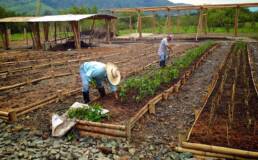
Bamboo is a resilient species that has had several diverse uses throughout human history, including medicine, food, weapon crafting, writing, charcoal, and housing. In fact, bamboo is considered to be one of the oldest building materials in human history. Bamboo is abundant in Southeast Asia, Central and East Africa, the Philippines, South America, Mexico, and the southern United States. [1]
Bamboo’s resilience is not limited to its human uses and growth patterns. As an ecological function, bamboo is highly beneficial to the larger ecosystem to which it belongs. By leaving roots in place when harvesting bamboo, soil erosion can be prevented, and nutrients can be retained. [2] Bamboo is also capable of absorbing up to 340% more CO2 than an average tree due to the higher rate of photosynthesis required to achieve maturity in 5-6 years.
Pulling CO2 out of the atmosphere is good for many reasons, primarily reducing the overall quantity of greenhouse gases that contribute to the warming of the planet. On a smaller scale, pulling CO2 out of the atmosphere also increases the quality of life for humans suffering from poor air quality conditions, which contribute to diseases such as asthma, kidney calcification, and loss of higher-level cognitive function. [3]
Reducing CO2 levels through bamboo cultivation has the added benefit of increasing the rate of photosynthesis in surrounding plant life. Studies have shown that long-term exposure to high levels of CO2 can cause plant leaves to thicken and slow photosynthesis due to restricted stomata channels. [4]
While all of these reasons support the idea of planting bamboo as a way to reduce atmospheric CO2, perhaps in exchange for carbon credits, bamboo has the potential to be utilized for so much more. As mentioned earlier, bamboo has been historically used to build houses. These houses were similar to traditional log cabins found in North America and made primarily from raw materials. While timber from trees has been engineered further into forms of dimensional lumber, there haven’t been major developments in the western world using bamboo to the same capacity. However, bamboo can yield twenty to fifty-seven times more timber than trees from the same amount of land while taking a tenth of the time to reach harvesting maturity, making it much more effective in yielding raw timber.
Our aim at Panda Industries is to harness the potential bamboo has in offering a more sustainable, more efficient alternative to using trees to produce timber while also providing a positive impact on local and global environments without compromising structural integrity.
